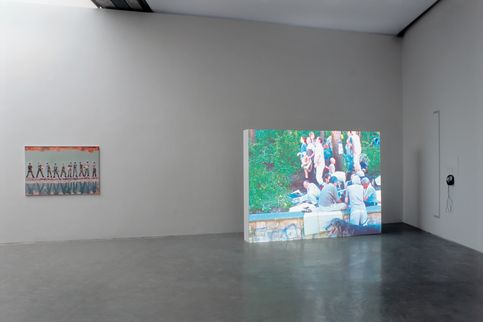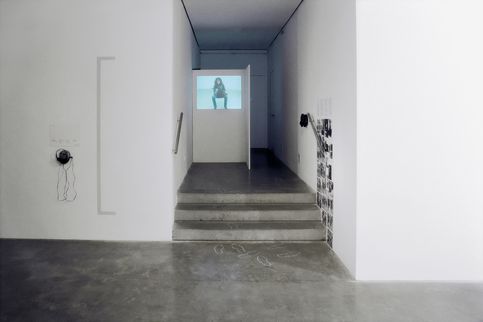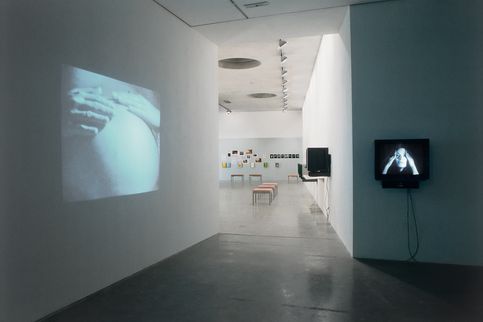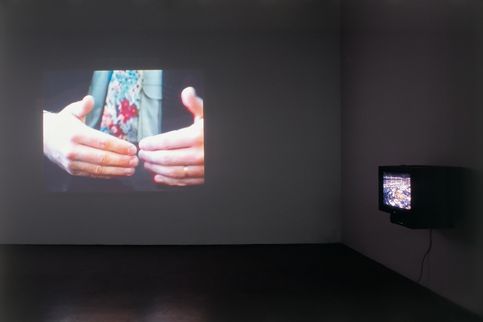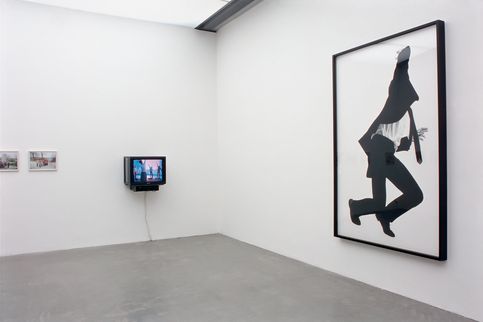That bodies speak
has been known for a long time.*
Curators: Hemma Schmutz, Tanja Widmann
Works by John Baldessari, Josef Dabernig, Thomas Eggerer, Michaela Grill/Martin Siewert, Maria Hahnenkamp, Ilse Haider, Daniel Herskowitz, Martha Jungwirth, Allan Kaprow, Mary Kelly, Ella Klaschka/Olivier Foulon, Robert Longo, Antje Majewski, Aernout Mik, Antoni Muntadas, Roman Ondák, Catherine Opie, Fiona Rukschcio, Deborah Schamoni/Ted Gaier, Meike Schmidt-Gleim, Rosemarie Trockel, Hannah Wilke, Francesca Woodman.
This international group exhibition, whose title quotes the French philosopher Gilles Deleuze, emphasized the languages of the body. The presentation concentrated on the body as the protagonist of both voluntary and involuntary actions, as the conveyor of contradictory messages, while at the same time highlighting its potential for resistance. In particular, the exhibition interrogated the influences and desires that affect gestic expression.
The Deleuze quote, taken from his essay on Pierre Klossowski (1979), intimates the theme of the exhibition: the body in its linguisticality. It acts as a provocative appeal to discuss afresh familiar questions: how do bodies produce language, how are they themselves grasped and defined by it, and what possibilities for action are opened up? The exhibition approached the "speaking body" via its gestic potential, combined at then time current artistic works with the historical strategy used by the art historian Aby Warburg. In his study, the "Mnemosyne Atlas" (1925-29), made up of illustrated plates, Warburg demonstrates how the gesture is open to contradictory interpretations: the comparative montage of historical art works from ancient times and the Renaissance made it clear that, in the course of time, one and the same gesture can be invested with new meanings. What Warburg called "pathos formulas" - the intense emotional movement of the body expressed in gestures - can thus mean both fear and euphoria, grief and joy, liberation and decline.
What lies in the expression of the gesture, therefore, is not so much an articulation of the inner world of an individual artist, as a discursive act in its repeatability. This is what creates the possibility of the gesture’s re-interpretation and its performative potential. As well as this repeatability, making the gesture open to new meanings, there is also the possibility of its being made to contain contradictory meanings. The art works presented in the exhibition drew on this productive element of tension in the gesture, and thus referred to an esthetic practice that takes disconcerting incongruity, dissonance, and ambiguity in film, art, and popular culture as points of departure for political and ethical options of action.The "Mnemosyne Atlas" by Aby Warburg gives a visual account of the memory of western culture, both in artistic productions and those of everyday culture. Setting out from the appearance of the often fleeting gesture in everyday contexts of life and work, the exhibition attempted - without laying claim to the status of a culturo-scientific study - to pose questions about potential for thought and action through the combination of images.
The plates of the "Mnemosyne Atlas" were also the visual starting point for the way the exhibition was structurally conceived. This form of pictorial thought, characteristic of Warburg, was reflected in the presentation of the art works in a free montage. As with Warburg’s plates, however, individual sections were bracketed together. A further motivation behind the form of presentation used in the exhibition was the possibility of using pictorial material as a kind of repository that could be endlessly configurated, without a definitive conclusion ever being reached.
A special image/text section containing theoretical texts and both art-historical and contemporary reference material provided the opportunity for further reading, with the aim of extending the timeframe of the art works shown in the exhibition. Aspects of prior research could also be seen here.
*Gilles Deleuze, "Pierre Klossowski or Bodies-Language", in: "The Logic of Sense", 1979

